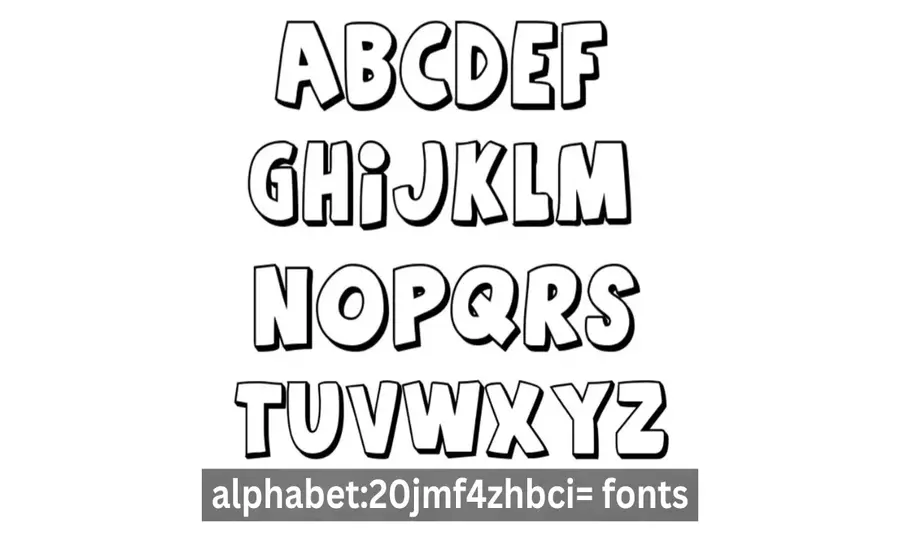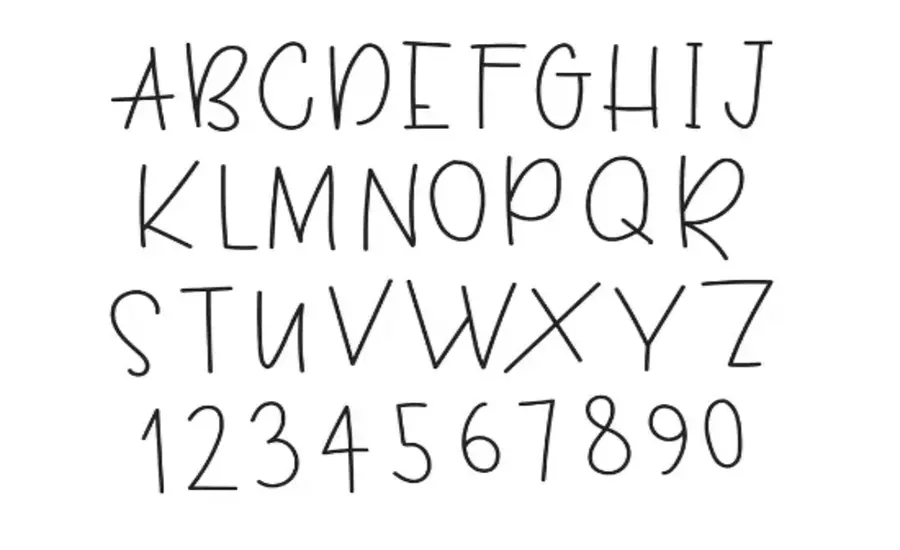Revolutionizing Digital Design & Brand Identity with Alphabet:20jmf4zhbci= Fonts
In the ever-evolving landscape of digital design, typography stands as a cornerstone of visual communication. The choice of fonts can profoundly impact the effectiveness of branding, influencing how a message is perceived and received by its audience. Furthermore, in this article, the emergence of Alphabet:20jmf4zhbci= fonts represents a transformative shift in digital design. This article explores the revolutionary potential of these fonts in shaping brand identity, enhancing user experience, and driving engagement across various digital platforms.
The Importance of Typography in Digital Design
Typography is more than just the selection of typefaces; it is a critical aspect of graphic design that conveys brand personality, establishes hierarchy, and enhances readability. In the digital realm, where first impressions are often made in mere seconds, effective typography can mean the difference between capturing a user’s attention and losing it to a competitor. The choice of font impacts not only aesthetic appeal but also functionality, as it can guide users through digital content, highlight key messages, and evoke emotional responses.
As digital interfaces become increasingly complex, the role of typography in creating intuitive and user-friendly experiences is more crucial than ever. A well-chosen font can communicate clarity and professionalism, while poor typography can lead to confusion and frustration. Designers must consider not only the visual aspects of typography but also its impact on usability and accessibility. This dual focus is essential for fostering effective communication in a crowded digital landscape.

Introducing Alphabet:20jmf4zhbci= Fonts
Alphabet:20jmf4zhbci= fonts represent a groundbreaking advancement in the field of typography. Developed with the needs of modern designers in mind, these fonts are characterized by their versatility, readability, and unique aesthetic appeal. The design philosophy behind Alphabet:20jmf4zhbci= fonts centers on creating typefaces that are not only visually stunning but also functional across a wide range of applications, from websites and mobile apps to print materials and branding collateral.
What sets Alphabet:20jmf4zhbci= fonts apart is their innovative design approach, which prioritizes legibility while allowing for creative expression. These fonts are crafted to adapt seamlessly to various screen sizes and resolutions, ensuring that text remains clear and engaging regardless of the platform. The fonts come in a diverse range of styles, weights, and variations, providing designers with the flexibility to match their branding needs and enhance their creative vision.
Enhancing Brand Identity Through Typography
In today’s competitive marketplace, establishing a strong brand identity is essential for success. Typography plays a pivotal role in this process, serving as a visual representation of a brand’s values, personality, and mission. The choice of fonts can communicate a brand’s essence, whether it be modern and innovative or traditional and reliable. With Alphabet:20jmf4zhbci= fonts, designers have the tools necessary to create a distinctive brand identity that resonates with their target audience.
Furthermore, a cohesive brand identity is built upon consistent visual elements, and typography is one of the most critical components of this equation. By selecting the right fonts and pairing them effectively, brands can create a unified look that reinforces their messaging across all channels. For instance, using bold, geometric typefaces can convey a sense of modernity and innovation, while serif fonts may evoke a feeling of tradition and trustworthiness. The ability to experiment with various styles and weights within the Alphabet:20jmf4zhbci= family allows brands to curate a typography palette that aligns with their overall vision.
In addition to visual consistency, typography also influences how a brand communicates with its audience. The tone of voice, whether it be playful, serious, or authoritative, can be conveyed through the careful selection of fonts. This nuanced approach to typography can enhance emotional connections with consumers, making them more likely to engage with a brand on a deeper level. By leveraging the unique characteristics of Alphabet:20jmf4zhbci= fonts, brands can craft compelling narratives that resonate with their audience and drive loyalty.
The Role of Typography in User Experience
User experience (UX) is a critical consideration in digital design, as it encompasses the overall satisfaction of users when interacting with a product or service. Typography plays a significant role in shaping UX, influencing everything from readability to navigation. A well-structured typographic hierarchy can guide users through content, making it easier for them to absorb information and take action.
Alphabet:20jmf4zhbci= fonts are designed with user experience in mind, prioritizing clarity and legibility across various devices and screen sizes. Furthermore, this commitment to usability ensures that users can easily engage with content, reducing cognitive load and enhancing satisfaction. Designers can implement typographic hierarchy through font sizes, weights, and spacing, allowing users to quickly identify headings, subheadings, and body text. This strategic organization of text not only improves readability but also facilitates effective information consumption.
Furthermore, the adaptability of Alphabet:20jmf4zhbci= fonts allows for consistent experiences across platforms, whether users are accessing content on a desktop, tablet, or mobile device. This responsiveness is crucial in a world where users expect seamless interactions with digital products. By utilizing these fonts, designers can create cohesive experiences that foster engagement and drive conversions.
Key Benefits of Using Alphabet:20jmf4zhbci= Fonts
- Versatility: Alphabet:20jmf4zhbci= fonts offer a diverse range of styles and weights, allowing designers to choose the perfect typeface for any project, from modern websites to classic print materials.
- Readability: These fonts are designed to maintain clarity across various screen sizes and resolutions, ensuring that text remains legible and engaging for users.
- Emotional Impact: The unique characteristics of Alphabet:20jmf4zhbci= fonts enable brands to convey specific emotions and messages, enhancing their overall identity and connection with consumers.
- Brand Cohesion: With a consistent typographic style, brands can create a unified look that reinforces their messaging and values across all touchpoints.
- User Experience: By prioritizing readability and usability, these fonts contribute to positive user experiences, encouraging engagement and satisfaction.

The Future of Typography in Digital Design
Furthermore, as technology continues to advance, the future of typography in digital design holds exciting possibilities. The integration of artificial intelligence and machine learning is already beginning to influence how fonts are created and utilized, with algorithms that can analyze user preferences and generate customized typography solutions. This trend towards personalization is set to reshape the landscape of digital design, allowing for more tailored experiences that resonate with individual users.
Moreover, as virtual and augmented reality technologies become more prevalent, typography will need to adapt to new mediums and environments. The challenge will be to create fonts that not only look good in traditional formats but also function effectively in immersive experiences. Alphabet:20jmf4zhbci= fonts are well-positioned to meet these challenges, as their innovative design principles allow for flexibility and adaptability in emerging technologies.
In addition, the growing emphasis on accessibility in design will continue to shape the future of typography. Designers must prioritize creating fonts that are inclusive and readable for individuals with diverse needs. Alphabet:20jmf4zhbci= fonts, with their focus on clarity and legibility, align well with these accessibility principles, offering solutions that cater to a wide range of users.
The Impact of Fonts on Digital Branding
The significance of typography in shaping brand identity cannot be overstated. Fonts are a visual representation of a brand’s values and personality, influencing consumer perceptions and preferences. In a world where consumers are bombarded with choices, effective branding is crucial for standing out. The use of Alphabet:20jmf4zhbci= fonts allows brands to create a distinctive voice in a crowded marketplace, enhancing their overall identity and recognition.
When brands consistently use specific fonts across various platforms, they reinforce their identity in the minds of consumers. This familiarity fosters trust and loyalty, as consumers come to associate the brand with its unique visual style. Moreover, as brands evolve, the ability to adapt typography while maintaining core visual elements becomes essential for staying relevant and engaging.
In summary, the impact of fonts on digital branding extends beyond aesthetics; it encompasses how consumers perceive and connect with a brand. By leveraging the versatility and unique characteristics of Alphabet:20jmf4zhbci= fonts, brands can craft compelling narratives that resonate with their target audience, driving engagement and loyalty.
The Role of Color in Typography
While typography is primarily concerned with the design of letters and words, color is a vital element that can enhance or detract from the effectiveness of typography. Color choices can evoke emotions, create visual hierarchies, and establish brand identity. The interplay between typography and color is critical in creating cohesive and impactful designs.
Furthermore, incorporating color into typography requires careful consideration, as it can influence readability and accessibility. High contrast between text and background colors is essential for ensuring legibility, while complementary color schemes can enhance visual appeal. Alphabet:20jmf4zhbci= fonts offer a range of design possibilities that can be effectively paired with various color palettes to create striking visual compositions.
Additionally, color psychology plays a significant role in how consumers perceive brands. Different colors evoke different emotions and associations, and designers must be mindful of these implications when selecting color schemes for their typography. By strategically combining Alphabet:20jmf4zhbci= fonts with thoughtfully chosen colors, brands can create a powerful visual narrative that resonates with their audience.
Integrating Typography and Color in Branding
- Establishing Visual Hierarchy: The use of contrasting colors can help establish a clear hierarchy in typography, guiding users through content and highlighting key messages.
- Eliciting Emotional Responses: Color choices can evoke specific emotions that align with a brand’s message, enhancing the overall impact of typography.
- Reinforcing Brand Identity: Consistent use of color in conjunction with typography can strengthen brand recognition and create a cohesive visual identity.
- Enhancing Readability: High contrast between text and background colors ensures that typography remains legible, even in complex designs.
- Creating Visual Interest: The interplay between typography and color can result in dynamic compositions that capture attention and engage users.

Practical Applications of Alphabet:20jmf4zhbci= Fonts in Design
The versatility of Alphabet:20jmf4zhbci= fonts makes them suitable for a wide range of design applications, from web design and branding to print materials and advertising. Here are some practical applications where these fonts can significantly enhance design outcomes:
Web Design
In web design, typography is a critical component of user experience. The choice of fonts can influence readability, navigation, and overall aesthetic appeal. Alphabet:20jmf4zhbci= fonts are designed to adapt seamlessly to various screen sizes and resolutions, ensuring that text remains clear and engaging across devices. By leveraging these fonts in web design, designers can create visually appealing layouts that enhance user engagement and drive conversions.
Branding and Identity
For businesses looking to establish a strong brand identity, typography is a fundamental element. Furthermore, Alphabet:20jmf4zhbci= fonts offer a diverse range of styles and weights, allowing designers to create a unique visual identity that reflects a brand’s values and personality. By selecting fonts that resonate with their target audience, brands can craft compelling narratives that foster emotional connections and drive loyalty.
Print Materials
Despite the rise of digital media, print materials remain an essential part of marketing and branding strategies. The clarity and versatility of Alphabet:20jmf4zhbci= fonts make them ideal for print applications, ensuring that text remains legible and visually appealing. From brochures and business cards to posters and packaging, these fonts can enhance the overall effectiveness of print communications.
Advertising
In advertising, typography plays a vital role in capturing attention and conveying messages effectively. The unique characteristics of Alphabet:20jmf4zhbci= fonts allow designers to create impactful advertisements that resonate with consumers. By combining eye-catching typography with compelling visuals, brands can create memorable campaigns that drive engagement and conversions.
Typography Trends to Watch
As digital design continues to evolve, several typography trends are emerging that will shape the future of branding and user experience. Designers must stay attuned to these trends to remain competitive and relevant in the industry. Here are some key typography trends to watch:
Variable Fonts
Variable fonts are a groundbreaking innovation that allows designers to access multiple styles and weights within a single font file. This flexibility enables more dynamic typography and allows for seamless adjustments in design without compromising performance. As variable fonts gain traction, Alphabet:20jmf4zhbci= fonts can embrace this trend, offering even greater versatility for designers.
Handwritten and Custom Fonts
The rise of personalized branding has led to an increased interest in handwritten and custom fonts. These unique typefaces convey authenticity and individuality, making them appealing for brands looking to differentiate themselves. Alphabet:20jmf4zhbci= fonts can incorporate elements of customization to cater to this growing demand for distinctive typography.
Bold and Experimental Typography
As designers seek to make bold statements, experimental typography is gaining popularity. This trend emphasizes creative font combinations, unconventional layouts, and striking visual contrasts. Alphabet:20jmf4zhbci= fonts can support this trend by offering diverse styles that can be paired in innovative ways to create eye-catching designs.
Sustainable Typography
With a growing emphasis on sustainability in design, typography is also being influenced by eco-friendly practices. This trend includes the use of fonts that are designed to minimize ink consumption in print materials and promote digital efficiency. Alphabet:20jmf4zhbci= fonts can play a role in this movement by prioritizing legibility and reducing waste in both digital and print applications.
Conclusion
The emergence of Alphabet:20jmf4zhbci= fonts represents a significant advancement in the field of digital design and branding. Furthermore, by prioritizing versatility, readability, and unique aesthetic appeal, these fonts empower designers to create compelling narratives that resonate with their target audience. Typography is not merely a design choice; it is a powerful tool for communication that can shape perceptions, influence emotions, and drive engagement.
As the digital landscape continues to evolve, the role of typography will remain crucial in enhancing user experiences and establishing strong brand identities. The ability to integrate typography with color, imagery, and overall design strategy will be essential for brands seeking to stand out in a crowded marketplace. With the innovative design principles of Alphabet:20jmf4zhbci= fonts, the future of typography holds exciting possibilities for revolutionizing digital design and brand identity.
By embracing the transformative power of typography, brands can craft unique experiences that resonate with their audience, fostering lasting connections and driving success in an increasingly competitive environment. In this journey toward effective communication, the thoughtful application of typography will undoubtedly play a pivotal role in shaping the future of design and branding.






